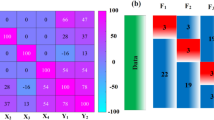Abstract
The main aim of this study was to enhance the product quality by improving dyeing process conditions of acrylic fiber used as raw material in a factory-produced carpet. There are three quality characteristics consisting of desired (nominal) color strength, maximized acrylic fiber strength and minimized dyestuff in dye bath. Dyeing temperature, fixation duration, softener, antistatic, amount of material (fiber), pH, retarder and dispergator, which have an influence on dyeing, were chosen as control factors. Dyeing temperature and antistatic were seemed to be significant factors on dyeing for 95 % confidence interval statistically. Optimal dyeing process conditions were determined by hybrid gray-based Taguchi–artificial neural network (ANN) method. Gray relational grade as a performance evaluation index obtained from gray relational analysis reduces the number of quality characteristics. Gray relational grade was found as 0.6630 for existing conditions and improved as 0.7749 by gray-based Taguchi ANN method. The suggested methodology improves quality of dyed acrylic fiber, reduces defective products and provides dyeing operations much more efficient. All of these translate into significant cost savings.





Similar content being viewed by others
Explore related subjects
Discover the latest articles, news and stories from top researchers in related subjects.References
Kuo CC, Pietras S (2010) Applying regression analysis to improve dyeing process quality: a case study. Int J Adv Manuf Technol 49:357–368
Ravikumar K, Krishnan S, Ramalingam S, Balu K (2006) Optimization of process variables by the application of response surface methodology to optimize the process variables for reactive red and acid brown dye removal using a novel adsorbent. Dyes Pigm 72:66–74
Kuo CFJ, Chang CD, Su TL, Fu CT (2008) Optimization of the dyeing process and prediction of quality characteristics on elastic fiber blending fabrics. Polym Plast Technol Eng 47(7):678–687
Hench KW, Al-Ghanim AM (1995) The application of a neural network methodology to the analysis of a dyeing operation. In: ANNIE ‘95: artificial neural networks in engineering, St. Louis, MO (United States), pp 873–878
Köksal G (1992) Robust design of batch dyeing process. Degree of Doctor of Philosophy, Department of Industrial Engineering, Graduate Faculty of North Carolina State University, Raleigh, NC
Kuo CFJ, Fang CC (2006) Optimization of the processing conditions and prediction of the quality for dyeing nylon and lycra blended fabrics. Fibers Polym 4:344–351
Jahmeerbacus MI, Kistamah N, Ramgulam RB (2004) Fuzzy control of dye bath pH in exhaust dyeing. Color Technol 120:51–55
Fjodorova N, Novic M, Diankova T (2011) Optimization of pigment dyeing process of high performance fibers using feed-forward bottleneck neural networks mapping technique. Anal Chim Acta 705:148–154
Asiaban S, Moradian S (2012) Investigation of tensile properties and dyeing behavior of various polypropylene/polyamide 6 blends using a mixture experimental design. Dyes Pigm 92(1):642–653
Barani H, Broumand MN, Haji A, Kazemipur M (2012) Optimization of dyeing wool fibers procedure with Isatis tinctoria by response surface methodology. J Nat Fibers 9(2):73–86
Zeydan M, Toğa G (2011) Reducing variation of dyeing process in textile manufacturing industry. World Academy of Science, Engineering and Technology, p 59
Furferi R, Governi L (2011) Prediction of the spectrophotometric response of a carded fiber composed by different kinds of coloured row materials:an artificial neural network-based approach. Color Res Appl 36(3):179–191
Furferi R, Carfagni M (2010) Prediction of the color and of the color solidity of a jigger-dyed cellulose-based fabric: a cascade neural network approach. Text Res J 80(16):1682–1696
Kiumarsi A, Abomahboub R, Rashedi SM, Parvinzadeh M (2009) Achillea millefolium, a new source of natural dye for wool dyeing. Progress in color, colorants and coatings, pp 287–293
Rangone A (1996) An analytical hierarchy process framework for comparing the overall performance of manufacturing departments. Int J Oper Prod Manag 16(8):104–119
Yedla S, Shrestha RM (2007) Application of analytic hierarchy process to prioritize urban transport options—comparative analysis of group aggregation methods, Indira Gandhi Institute of Development Research, Mumbai
Ramanathan R, Ganesh LS (1994) Group preference aggregation methods employed in AHP: an evaluation and intrinsic process for deriving members’ weightages. Eur J Oper Res 79:249–265
Saaty TL (1980) The analytic hierarchy process. McGraw-Hill International, New York
Deng JL (1989) Introduction to grey system theory. J Grey Syst 1:1–24
Zeydan M (2008) Modelling the woven fabric strength using artificial neural network and Taguchi methodologies. Int J Cloth Sci Technol 20(2):104–119
Önal L, Zeydan M, Korkmaz M, Meeran S (2009) Predicting the seam strength of notched webbings for parachute assemblies using the Taguchi’s design of experiment and artificial neural networks. Text Res J 79(5):468–478
Haykin S (1994) Neural networks—a comprehensive foundation. Macmillan College Publishing, ISBN, New York
Xu S, Chen L (2008) A novel approach for determining the optimal number of hidden layer neurons for FNN’s and its application in data mining. In: Proceedings of 5th international conference on information technology and applications (ICITA 2008), Cairns, Queensland, Australia, pp 683–686, ISBN 978-0-9803267-2
Behera BK, Karthikeyan B (2006) Artificial neural network-embedded expert system for the design of canopy fabrics. J Ind Text 36(2):111–123
Acknowledgments
The authors would like to thank reviewers because of their invaluable comments and suggestions for the preparation of the revised manuscript.
Author information
Authors and Affiliations
Corresponding author
Appendix
Appendix
See Table 23.
Rights and permissions
About this article
Cite this article
Zeydan, M., Yazıcı, D. Improvement of process conditions in acrylic fiber dyeing using gray-based Taguchi-neural network approach. Neural Comput & Applic 25, 155–170 (2014). https://doi.org/10.1007/s00521-013-1457-0
Received:
Accepted:
Published:
Issue Date:
DOI: https://doi.org/10.1007/s00521-013-1457-0




